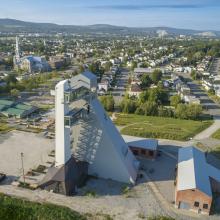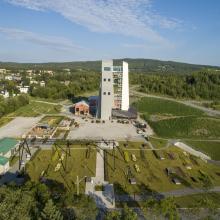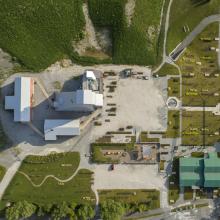Image set

Related services
Related sectors
Related regions
Opening article section
Article section
Rich text
Thetford Mines bears the marks of its history. For a hundred years, it was the scene of the conquest of “white gold”, often referred to as the asbestos capital of the world. Neighbourhoods were relocated to extract asbestos and maximize yield.
Now a thing of the past, this mining activity has left behind a unique, somewhat lunar landscape, with its numerous accumulation mountains, the spoil tips, composed of asbestos residue. Urgent action was needed to limit erosion and spills into nearby waterways.
Our team of specialists carried out two projects that put our expertise to work helping transform ravaged areas by regreening them and bringing back biodiversity.
Rich text
Revitalizing with ingenuity
Englobe has been part of the solution for several years. Initially, we were commissioned to regreen 100 hectares of spoil tips at former British Canadian Mine 1 in the Black Lake area. To achieve this, we created a plant cover that was over one metre deep made of recovered materials and fertilizers that were destined for landfill.
Turning over a new leaf with leaves
Recovered materials included compost, municipal mud, wood chips and dead leaves as green waste We then planted a grass and legume meadow as well as 20,000 white spruce trees. In each of our revitalization projects, we work with specialists and choose native species that will grow well in their environment. Among other things, we work with agronomists to create balanced soils that allow plants to grow in a sustainable manner.
Article quote
Media
Image set

Rich text
In the Englobe park, the past looks to the future
The city of Thetford Mines and the Minéro Museum commissioned Englobe to create a park on the King Mine | KB3 Historical Centre site , which highlights the city’s mining history. This restored exhibition space, located at the entrance to the iconic King Mine, is built around the shaft and includes an underground exhibition gallery and old buildings. Our team was immediately excited about this project and wanted to get involved, in partnership with the museum, the city and a number of people in the community. It was also a great way for Englobe to say thank you.
To backfill and shape the terrain, the plan suggested building a circular economy and using recycled soil, which had the double advantage of being less costly and greener since thousands of tons of soil would be diverted from the landfill. As a stakeholder in the project, Englobe also decided to take charge of applications for government approvals. Today, the park, which is about the size of two football fields, is dotted with trails and multiple species of grasses and trees. Wildlife—and the local population—have reclaimed it.
Rich text
The butterfly effect: hummingbirds, bees, deer and turkeys
All this effort has helped rebalance the ecosystem, and nature has re-established itself. At Englobe, this is exactly the kind of project that drives us. We exist to help our clients and the communities we work with create a sustainable, long-lasting and promising future.The Englobe park is our pride and joy. When you’re in the area, observe the many species of plants and animals, walk through the park and step back in time by exploring the museum.
Article quote
Rich text
A few impressive facts and figures about the revitalization of the park
- Over 8,000 m2 of land were developed.
- Over 16,000 tons of recycled soil were used for the project, which is the equivalent of 1,103 10-wheel trucks that, if put end to end, would be nearly 14 km long.
- Over 700 tons of compost were used for the vegetation layer.
- 400 trees were planted, including maple, spruce and oak, as well as fruit trees such as mountain ash, elderberry and serviceberry.
Media
Image set
